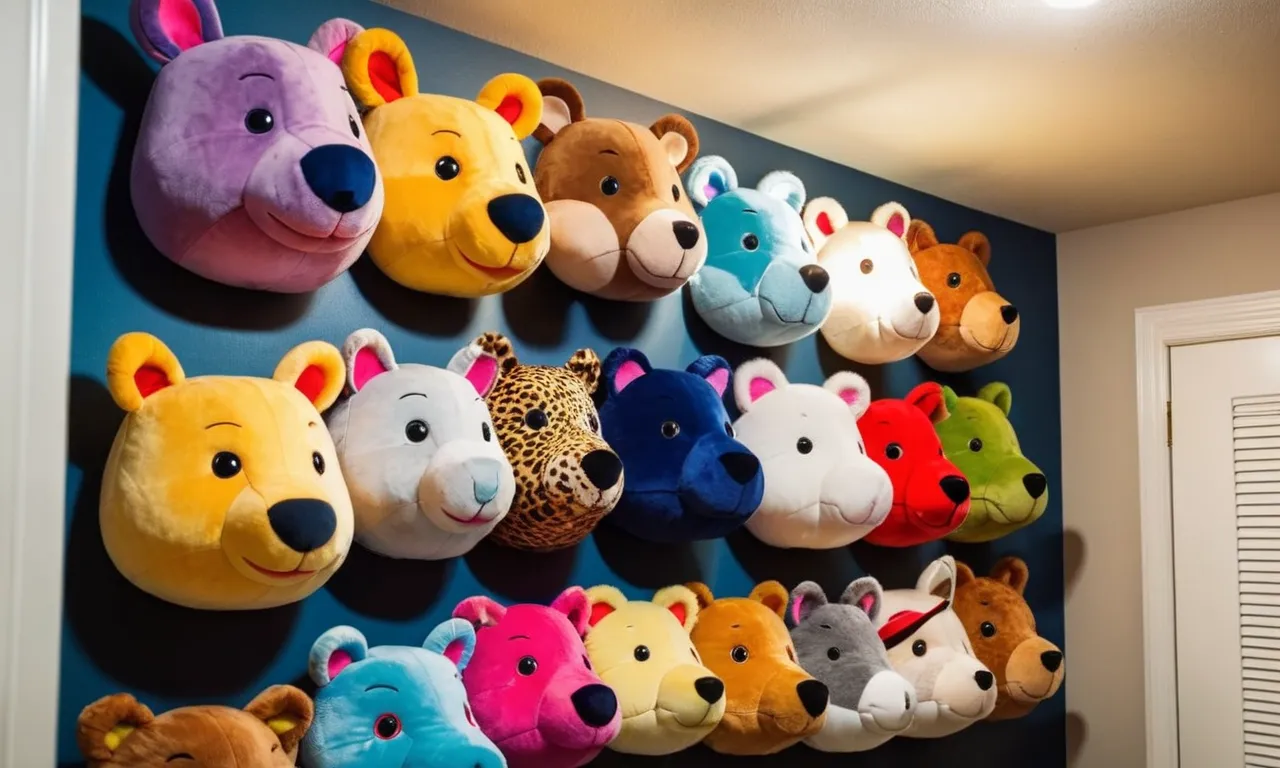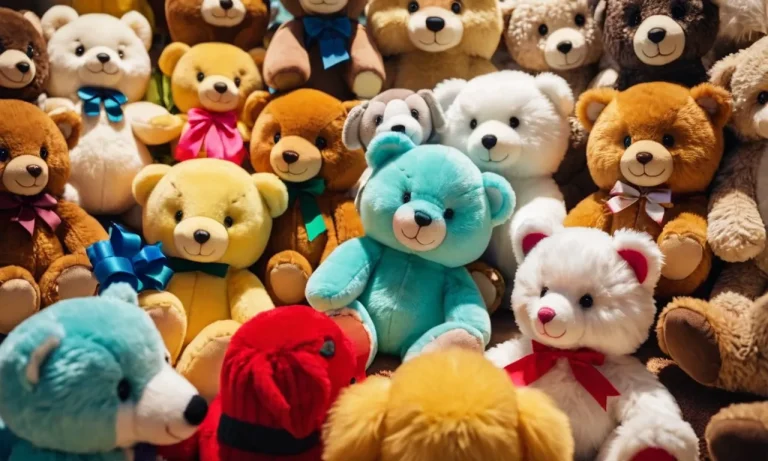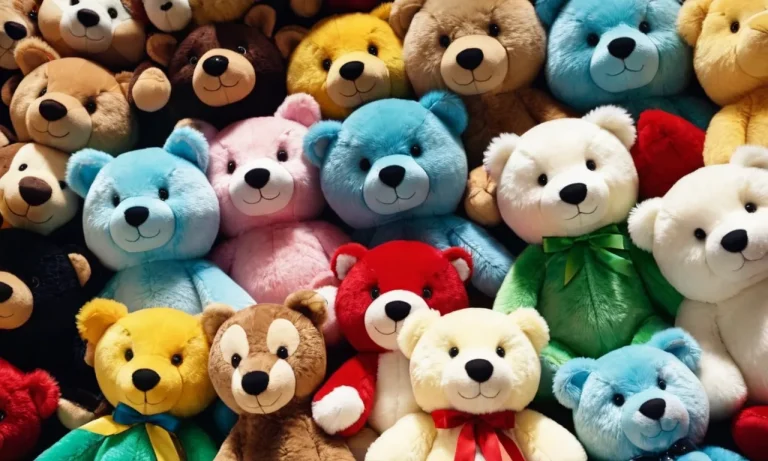Do you have a beloved collection of stuffed animals that you want to proudly display in your home? Hanging stuffed animals on the wall is a fun way to decorate while freeing up space elsewhere. If you’re short on time, here’s a quick answer to your question: Use command hooks, shelves, nets, pegboards with hooks, or wire storage cubes to hang stuffed animals on the wall securely.
In this comprehensive guide, we’ll explore various methods for mounting stuffed animals to your wall safely and tips for creating an eye-catching display.
Assessing Your Stuffed Animal Collection
Take Stock of Size, Weight & Materials
Taking inventory of your stuffed animal collection is an important first step before hanging them on the wall. Consider the size, weight and materials of each one. Larger or heavier plushes may require more reinforcement to securely mount them without risk of falling.
Delicate materials like sequins or fabrics may get damaged over time from dust or sunlight if not properly protected.
Group your stuffed animals by size – small (under 8 inches), medium (8-16 inches), and large (over 16 inches). Then separate by weight and materials. Heavier wool or microfiber plushes versus lighter cotton or polyester ones.
This helps determine if any will need extra mounting support like thicker hooks, additional screws or placement away from direct sun exposure.
Group Similar Plush Toys Together
Creatively grouping similar plushies together builds a cohesive display. Carnival prizes can make a fun theme. Or collect all your favorite characters into one area. Animals, food shapes or holiday décor work nicely as well. Mix textures, colors and styles within each grouping to add visual interest.
Plan display groupings on paper first before mounting for best results. Shelves or floating ledges allow grouping multiple plushes. While single toy hooks scattered artfully can accent walls between groupings. Ensure groupings are balanced for size and weight.
Heavier or larger collections on bottom with lighter plushies above. Have fun and get creative with your own personalized plush wall art!
Choosing a Mounting Method
Command Hooks for Lightweight Plush
If your stuffed animal collection is on the smaller side, command hooks are a great option for mounting them to the wall. Command hooks use a strong adhesive that lets you hang lightweight items without nails or screws.
This makes them perfect for hanging up a couple of plushies without damaging your walls.
When selecting command hooks, opt for ones that can hold about 4 pounds per hook. This gives you enough of a safety margin for hanging most lightweight stuffed animals. Pick hooks with wide, flat heads for additional stability.
Position hooks at varying heights on your wall to create a visually interesting display of your favorite plush pals.
Some key benefits of using command hooks include:
- Easy to install and remove without damaging walls
- Hold up to 4 pounds per hook, suitable for lightweight plushes
- Adjustable – rearrange stuffed animals easily
Floating Shelves for Medium-Sized Collections
For medium collections of 15-30 stuffed animals, floating shelves give you an eye-catching wall display option. Floating shelves come in various materials like wood, metal, or acrylic. They conveniently mount onto walls with included hardware to look like they’re “floating.”
When picking shelves, make sure to check the weight capacity to ensure they can handle the total number and weight of plushies you want to display. Measure your collection and space first to select the right shelf sizes. Mix up shelf dimensions to create visual interest.
Place your very largest or special stuffed animals on the biggest shelves first, then arrange smaller plushies on the other shelves.
Key perks of floating shelves for stuffed animal displays include:
- Sleek, contemporary look
- Various sizes accommodate medium collections
- Distinct tiers neatly show off plushies
Mounting Your Stuffed Animals Securely
Use Adhesive Hooks Properly
When using adhesive hooks to hang stuffed animals, proper use is key for safety and security. Choose hooks specifically designed for hanging objects on walls, like Command Hooks. Before sticking them to the wall, clean the surface with rubbing alcohol and let it fully dry.
Firmly press the entire adhesive strip on the hook against the wall for over 30 seconds to ensure full contact. Wait 1 hour before hanging anything on newly mounted hooks to allow the adhesive to set. When attaching stuffed animals, hang them by loops sewn into parts of their body rather than by limbs or tails which could detach.
Check hooks regularly for loosening and reapply if necessary. With proper adhesive hook use, you can securely display even large or heavy stuffed animals.
Reinforce Shelves
For stuffed animal displays on shelves, reinforce the shelf properly to handle the weight. For medium or large collections, look for solid wood shelves rather than particle board which can sag over time. Or choose a shelf with thick, sturdy brackets and supports.
Metal bar shelf brackets or L-brackets provide excellent reinforcement and resist bending. Before loading up your stuffed animal shelf, secure brackets to studs in the wall with heavy-duty screws. For extra support, install triangular corbels or brackets underneath shelves, especially in the middle where most weight will be.
Ensure shelves are completely level so stuffed animals don’t slide or fall. With reinforced mounting, you can neatly and safely organize even large stuffed animal collections on shelves.
Maximize Pegboard Weight Capacity
Pegboard offers a cute way to display stuffed animals, but weight limitations must be considered. Standard pegboard holds only about 20-30 pounds. Heavier collections will require reinforcements. Choose thick 1/2-inch or 5/8-inch pegboard rather than 1/4-inch, and look for pegboard made of hardy hardboard rather than cardboard which can buckle.
Securely bolt deep-threaded pegboard anchors through the board and into studs, not just drywall. For large groups or heavy plushes, install T-braces or L-brackets underneath to support weight. Space out stuffed animals over the entire area rather than clustering in one spot to distribute weight.
Follow all pegboard weight limits and reinforcement instructions to safely mount stuffed buddies while avoiding collapsed pegboard disasters!
Creative Display Tips
Mix & Match Heights
When hanging your stuffed animal collection, play around with placing plushies at different heights across the wall for visual interest.
For example, you can cluster small and medium-sized plushes together in one area, while having a few large teddy bears popping out above them. Or arrange them to look like they are climbing up the wall!
Mixing up the heights adds dimension and a fun, dynamic look. It also allows you to feature more of your favorite furry friends.
Incorporate Other Decor
Incorporate plushies into wall displays with shelves, frames, macrame hangers, wreaths, and other decor items.
Some ideas:
- Hang stuffed animals from macrame or wreath hangers
- Display small plushies in the cutout shapes of wall-mounted geometric shelves
- Arrange stuffed animals alongside framed photos, art prints, or posters
This makes your display appear more curated and purposeful. The additional decorative elements complement the whimsical nature of the plushies.
Light It Up For Drama
Use string lights, wall sconces or table lamps to draw attention to special pieces.
Backlighting stuffed animals creates intriguing silhouettes and shadows on the wall. It also makes them pop off the wall visually.
Some lighting ideas:
- Outline plushies with twinkle lights for a magical effect
- Install sconces or directional lighting above or near favorite pieces
- Place a standing lamp near the wall to produce dramatic shadows
Lighting allows you to put the spotlight on your most beloved and interesting plushies. 💡It takes the display to another level for guests’ viewing pleasure!
Maintenance
Checking Attachments
To ensure your stuffed animals remain securely mounted, it’s important to periodically check that all attachments are still tight and intact. Use your fingers to gently tug on each stuffed animal to confirm hooks, command strips, nails, or other fasteners are still firmly grasping the wall and toy (but be gentle so as not to accidentally disconnect!).
Any loose attachments should be reinforced right away to prevent a sad loss of a beloved plushie. A quick attachment check every 3-6 months is generally sufficient.
Surface Cleaning
While out of reach of dirt and sticky fingers, wall-mounted stuffed buddies still accumulate dust over time. To freshen up their fluffy looks, attach a soft brush to a duster handle for easy reach. Gently brush the surface of each toy every few months to whisk away dust bunnies.
If more intensive cleaning is needed, carefully detach the toy and refer to manufacturer guidelines on if surface washing is allowed. When in doubt, spot clean small area with a gentle laundry detergent and avoid submerging the toy in water to prevent damage.
For the wall itself, wipe down the area around each toy every few months with a microfiber cloth to pick up any airborne dust and keep your display looking its best. 👍
Protecting Light Colors
Stuffed pals dressed in white or other light colors run the risk of yellowing over time when exposed to sunlight and harsh lighting. To help safeguard your light-colored buddies’ pristine plush coats, attach self-adhesive UV-protection film on nearby windows which shine direct light onto your displayed friends.
Replace the film every 1-2 years as its protective abilities diminish over time.
Also consider utilizing museum display lighting techniques, which use low-heat LED bulb spotlights directed precisely onto each toy rather than overhead lighting spanning the whole display. This focused lighting preserves the toys’ colors and materials much longer than widespread harsh lighting.
Awesome! 🎉
| Attachment Checking Frequency | Surface Cleaning Frequency | UV Film Replacement |
|---|---|---|
| Every 3-6 months | Every few months | Every 1-2 years |
By regularly inspecting attachments, gently cleaning surfaces, and taking steps to protect light-colored stuffed friends from fading, you can enjoy your artistic stuffed animal wall display in tip top shape for years to come.
For more handy tips, check out the stuffed animal care guides from the Ty Collector and Build-A-Bear Workshop sites.
Conclusion
Displaying stuffed animals creatively on your wall saves space while showing off your treasured plush collection. Assess the size and materials first, then choose a mounting method that can handle the weight.
Use strong adhesives, reinforce shelves, distribute weight evenly, and get creative with arrangements and lighting. Check attachments periodically and clean surfaces to maintain your toy wall art.







